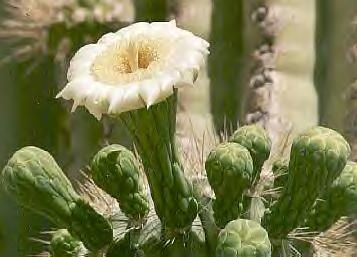|
|
|
|
Saguaro Special
|
Not having a reliable water source, these Indians measured strength by the ability to go without water in their arid climate. According to the mythology of the O'odham people, the first Saguaro was created when a young woman sank into the earth and rose back out as a giant cactus, arms raised toward the heavens. They, too, considered themselves as belonging to the earth. In hot June and early July, families would camp near forests of Saguaro to reap fruits from atop the giants, the plants they thought to be like themselves, Indians to be respected. The full crop of Saguaro fruit, which appeared even after a dry winter, might have seemed miraculous to them. Long poles made from the wooden ribs of Saguaro skeletons were used to hook and knock down the fruits. Like tiny watermelons when split open by hand, the fruit reveals a red interior pulp and thousands of black-red seeds (smaller then poppy seeds). The pulp, tasting like a fig with a hint of strawberry, quenches the thirst.
Gilded flickers and gila woodpeckers carve holes into saguaros for their nests. Once the chicks are on their own, the nests are abandoned and then inhabited by owls, wrens, finches, starlings, bats and insects. The surface of the holes, often shaped somewhat like deep, elongated bowls, become hardened and incredibly tough. These boots can be found within the ribs of long-fallen Saguaros. How far back the gathering of the Saguaro fruit goes no one knows for sure. Humans are believed to have arrived in the Southwest 10 to 11,000 years ago, about the time Saguaros are thought to have established themselves in the Sonoran Desert range.
A usual routine might find the family in the evening or early morning removing the fruit from the Saguaro with their harvesting tool held on the shoulder. The heat of the day would be a time for cooking the juice over a wood fire until reduced to a thick syrup. Drying or soaking would separate the pulp from the seeds, which would then be used to make porridge or crunchy candy. If you are in Saguaro country can you pick a Saguaro fruit? A Ranger at Saguaro National Park outside Tucson indicated that a tiny sampling of the renewable fruit is usually permitted on public lands. But the gathering of fruit in any quantity by the general public is prohibited. Harvesting Saguaro fruit from private land requires permission of the landowner. Fun Facts:
|

|
|
1/2 cup Saguaro fruit, diced 3/4 cup watermelon, diced 1/2 cup cantaloupe, diced 1/4 cup red onion, finely chopped 1/2 cup rice wine vinegar 4 Tbsp honey 1/2 tsp dried crushed red chili pepper |
|
Combine all ingredients and toss until well mixed. Chill. Can be served with fish, chicken or chips. |
|
|
|
|
|
Spring Saguaro Cream Serves 6-8 |
| Soak gelatin in cold water for 5 minutes. Add, with lemon juice, sugar and salt to the boiling water; stir until gelatin is dissolved. Chill until it begins to thicken, then stir in fruit. Fold in whipped cream and chill until set. To serve, garnish with additional fruit if desired. | |
|
|
|
|
Saguaro Seed Scones Makes 12 |
1/4 cup Saguaro seeds, ground in blender 2 cups flour 1/3 cup sugar 1/2 teaspoon each baking soda and salt 2 teaspoons baking powder 5 tablespoons cold butter 1 egg, beaten 2/3 cup buttermilk 2 teaspoons butter, melted 1 tablespoon Saguaro seeds |
| To prepare the seeds, add equal water to fruit breaking up pulp with hands and soak for at least 10 hours. Strain the liquid into a pot for other use. Dry the remaining seeds on a tray in the oven or in the sun. Shake pans to remove remaining pulp. | |
| Preheat oven to 400 degrees Fahrenheit. Stir together in a chilled bowl the ground Saguaro seeds, flour, sugar, baking soda, baking powder and salt. Cut cold butter into pieces and rub into dry ingredients, using fingers until butter is broken up and coarse crumbs form. | |
| Stir in beaten egg and buttermilk to make a soft dough. Place dough on lightly floured board and knead 5 to 7 times. Separate dough in half and make circles about 6 inches in diameter and 1/4 inch thick. Cut each circle into 6 wedges. | |
| Place scones on greased baking sheet leaving space between. Brush with melted butter and sprinkle with sugar and whole Saguaro seeds. Bake about 15-20 minutes, until tops are golden brown and puffy. Sprinkle with more sugar if desired. Cool on rack. | |
|
Serve with jam, honey or lemon curd. |
|
|
|
| Canku Ota is a free Newsletter celebrating Native America, its traditions and accomplishments . We do not provide subscriber or visitor names to anyone. Some articles presented in Canku Ota may contain copyright material. We have received appropriate permissions for republishing any articles. Material appearing here is distributed without profit or monetary gain to those who have expressed an interest. This is in accordance with Title 17 U.S.C. section 107. |
|
Canku Ota is a copyright of Vicki Lockard and Paul Barry. |
|